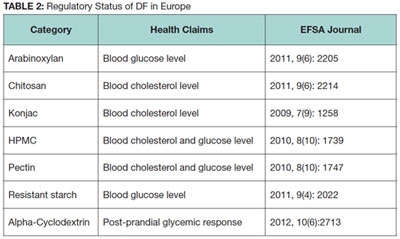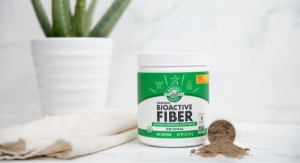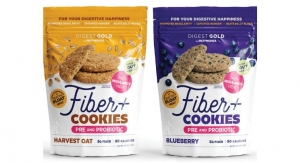Dilip Ghosh, PhD, FACN, nutriConnect05.01.14
Dietary fiber (DF) consists of non-digestible carbohydrates and lignins that are intrinsic and intact in plants. Functional fiber (FF) consists of isolated, non-digestible carbohydrates that have beneficial physiological effects in humans (see Table 1).
Total fiber is the sum of dietary and functional fiber. These definitions broaden the category and allow resistant starches, oligosaccharides and other non-digestible carbohydrates to be classified as functional fibers. The adequate intake for fiber defined by the Dietary Reference Intake (DRI) is 38 grams/day for adult men and 25 grams/day for adult women. There was insufficient evidence to set a tolerable upper intake level for dietary or functional fiber.

Genesis
Hippocrates, in the fourth century BC, recommended the consumption of breads made from unrefined flour. Several hundred years later, in the 19th century, the brothers J.H. and W.K. Kellogg developed food products based on the perceived benefits of whole grain cereals. However, the real scientific definition of fiber (“unavailable carbohydrate”) came from McCance and Lawrence in 1929. Over the past 200 years, the intake of DF, which was always a significant part of the human diet, has gradually decreased. Since the basic work of Burkitt & Trowell in the early 1970s on the relationship of DF and metabolic syndromes, many studies have been undertaken and support a protective role for DF in the prevention and management of chronic diseases.
Where Are We Now?
It’s no secret that the American diet has been severely devoid of dietary fiber for decades. Not only Americans but other populations also consume only about half of the daily DRI. Interestingly, it’s something consumers are well aware of; recent Tate & Lyle research found that 47% of consumers said they need more fiber in their diet, acknowledging they don’t take in the recommended amount.
Regulatory Definition of Fiber
The whole fiber industry was in confusion until the Codex Alimentarius Commission (CAC) published its fiber definition. To qualify as a fiber you should have an approved analytical method to accurately and precisely determine the dietary fiber content of foods with that ingredient.
Finally in 2010 the CAC announced a general definition and analytical approach for fiber. Fiber is now defined as: 1) naturally occurring edible carbohydrate polymers; 2) carbohydrate polymers obtained from food raw material by physical, enzymatic or chemical means; and 3) synthetic carbohydrate polymers. These polymers must have 10 or more monomeric units, and it’s up to national authorities on whether to include those with 3-9 monomeric units.
Adverse Effects of Dietary Fiber
There are a few well-authenticated adverse effects of dietary fiber in humans, but these are all minor and short-lived in nature, such as abdominal discomfort or flatulence. The possible adverse effects of high fiber diets on mineral status have been reported, but are thought to be almost entirely due to phytate rather than to the polysaccharides. There are occasional reports of intestinal obstruction due to abnormally high intakes of wheat bran, but again these are usually associated with pre-existing intestinal abnormalities.
Fiber & Satiety
A large body of evidence indicates fiber increases satiety and reduces food intake. However, in reality, not all types of fiber produce the same effects. There is a growing tendency to use functional fibers in foods and beverages and effectively increase the fiber content of low-fiber foods and drinks.
However, despite the increased use of such fibers, little research has been done to determine convincingly their effects on appetite and food intake. In support of this limited use, one recent study (Karalus et al. 2012. J Acad Nutr Diet. 112:1356-1362) suggested a limited role for 10 grams of oligofructose, inulin, soluble corn fiber and resistant wheat starch in acute satiety and energy intake.
Beyond Metabolic Syndrome
DF is considered to be a key component in healthy eating. Health benefits include the prevention and mitigation of type 2 diabetes mellitus, cardiovascular disease and colon cancer. By modulating physiological processes at food ingestion, digestion, absorption and metabolism levels, DFs reduce the risk of hyperlipidemia, hypercholesterolemia and hyperglycemia.
Emerging research has begun to investigate the role of DFs in immunomodulation. If substantiated, DFs could facilitate many biologic processes, including infection prevention and the improvement of mood and memory. Emerging research has suggested DF may influence immunity by altering plasma concentrations of key bioactive substances, such as C-reactive protein (CRP) and TNF-alpha. Modulation of the gut flora, likely tied to SCFA and FFA2, suggested a link to sickness symptoms and cognitive function via the brain-cytokine system (Kaczmarczyk et al. 2014. Metabol Clin Expt, 1058-1066).
Dietary Fiber & Health Claims
Several hundred health claim applications for specific biomaterials have been presented to the European Food Safety Authority (EFSA) Panel on Dietetic Products, Nutrition and Allergies. Most have been rejected because in the panel’s opinion there was insufficient evidence to justify the claim, despite published information about biological behavior. Only a few DF claims have gone through this stringent evaluation to approval stage (see Table 2).

A Unique Case Study
Alpha-cyclodextrin received EFSA’s favorable approval in 2012 based on post-prandial glycemic response. The unique structure of this dietary fiber allows it to form a stable, non-digestible complex with dietary fat. Just as the fiber-fat complex is non-digestible, it is also non-fermentable, thus eliminating messy side effects. A Sydney, Australia-based natural medicine company, SFI, has recently introduced Calorease for weight management with the patented FBCx fat binder in the North American market. FBCx is a patented alpha-cyclodextrin-based soluble dietary fiber with the unique ability to bind and eliminate nine times its own weight in dietary fat. Several positive clinical outcomes from randomized, placebo-controlled trials demonstrated its health benefits and supported its incorporation into a diabetic management regimen. Other health benefits include improved cholesterol and triglyceride levels and improved insulin sensitivity.
The Way Forward
Metabolic syndrome, characterized by obesity, hyperlipidemia, hypertension, insulin resistance and type 2 diabetes, is a growing epidemic worldwide, requiring new prevention strategies and therapeutics. Dietary regimens for weight loss have so far been unsuccessful in the general population and focus has turned to improving the quality of food. One strategy could be to develop prebiotics, dietary components that are fermented by the colonic microbiota and stimulate the growth of specific bacteria, where some of the bacterial metabolites formed may have beneficial effects on health.
A few recent groundbreaking experiments have shown the gut microbiota is involved in energy metabolism. Accordingly, an obese microbiota has an increased capacity to extract energy from the diet. Furthermore, it has been shown that the composition of bacteria in the gut differed between lean and obese individuals. Targeted probiotic interventions might prove efficient in patients with Metabolic syndrome. The multifunctional diet concept is another way of imposing a larger effect on the metabolic system. Taken together, future prebiotics should have the capacity to alter the gut microbiota, insulin levels and SCFA profiles; decrease systemic inflammation; increase satiety; and reduce oxidative stress and gastric emptying (Jakobsdottir et al. 2014. Nutrition 30: 497-502).
Dilip Ghosh, PhD, FACN, is director of nutriConnect, based in Sydney, Australia. He is also professionally involved with Soho Flordis International, the University of Western Sydney, Australia, and is an Honorary Ambassador with the Global Harmonization Initiative (GHI). Dr. Ghosh received his PhD in biomedical science from University of Calcutta, India. He has been involved in drug-development (both synthetic and natural) and functional food research and development both in academic and industry domains. Dr. Ghosh has published more than 60 papers in peer-reviewed journals, and he has authored two recent books, “Biotechnology in Functional Foods and Nutraceuticals,” and “Innovation in Healthy and Functional Foods,” under CRC Press. His next book, “Clinical Perspective of Functional Foods and Nutraceuticals” is in press. He can be reached at dilipghosh@nutriconnect.com.au; www.nutriconnect.com.au.
Total fiber is the sum of dietary and functional fiber. These definitions broaden the category and allow resistant starches, oligosaccharides and other non-digestible carbohydrates to be classified as functional fibers. The adequate intake for fiber defined by the Dietary Reference Intake (DRI) is 38 grams/day for adult men and 25 grams/day for adult women. There was insufficient evidence to set a tolerable upper intake level for dietary or functional fiber.
Genesis
Hippocrates, in the fourth century BC, recommended the consumption of breads made from unrefined flour. Several hundred years later, in the 19th century, the brothers J.H. and W.K. Kellogg developed food products based on the perceived benefits of whole grain cereals. However, the real scientific definition of fiber (“unavailable carbohydrate”) came from McCance and Lawrence in 1929. Over the past 200 years, the intake of DF, which was always a significant part of the human diet, has gradually decreased. Since the basic work of Burkitt & Trowell in the early 1970s on the relationship of DF and metabolic syndromes, many studies have been undertaken and support a protective role for DF in the prevention and management of chronic diseases.
Where Are We Now?
It’s no secret that the American diet has been severely devoid of dietary fiber for decades. Not only Americans but other populations also consume only about half of the daily DRI. Interestingly, it’s something consumers are well aware of; recent Tate & Lyle research found that 47% of consumers said they need more fiber in their diet, acknowledging they don’t take in the recommended amount.
Regulatory Definition of Fiber
The whole fiber industry was in confusion until the Codex Alimentarius Commission (CAC) published its fiber definition. To qualify as a fiber you should have an approved analytical method to accurately and precisely determine the dietary fiber content of foods with that ingredient.
Finally in 2010 the CAC announced a general definition and analytical approach for fiber. Fiber is now defined as: 1) naturally occurring edible carbohydrate polymers; 2) carbohydrate polymers obtained from food raw material by physical, enzymatic or chemical means; and 3) synthetic carbohydrate polymers. These polymers must have 10 or more monomeric units, and it’s up to national authorities on whether to include those with 3-9 monomeric units.
Adverse Effects of Dietary Fiber
There are a few well-authenticated adverse effects of dietary fiber in humans, but these are all minor and short-lived in nature, such as abdominal discomfort or flatulence. The possible adverse effects of high fiber diets on mineral status have been reported, but are thought to be almost entirely due to phytate rather than to the polysaccharides. There are occasional reports of intestinal obstruction due to abnormally high intakes of wheat bran, but again these are usually associated with pre-existing intestinal abnormalities.
Fiber & Satiety
A large body of evidence indicates fiber increases satiety and reduces food intake. However, in reality, not all types of fiber produce the same effects. There is a growing tendency to use functional fibers in foods and beverages and effectively increase the fiber content of low-fiber foods and drinks.
However, despite the increased use of such fibers, little research has been done to determine convincingly their effects on appetite and food intake. In support of this limited use, one recent study (Karalus et al. 2012. J Acad Nutr Diet. 112:1356-1362) suggested a limited role for 10 grams of oligofructose, inulin, soluble corn fiber and resistant wheat starch in acute satiety and energy intake.
Beyond Metabolic Syndrome
DF is considered to be a key component in healthy eating. Health benefits include the prevention and mitigation of type 2 diabetes mellitus, cardiovascular disease and colon cancer. By modulating physiological processes at food ingestion, digestion, absorption and metabolism levels, DFs reduce the risk of hyperlipidemia, hypercholesterolemia and hyperglycemia.
Emerging research has begun to investigate the role of DFs in immunomodulation. If substantiated, DFs could facilitate many biologic processes, including infection prevention and the improvement of mood and memory. Emerging research has suggested DF may influence immunity by altering plasma concentrations of key bioactive substances, such as C-reactive protein (CRP) and TNF-alpha. Modulation of the gut flora, likely tied to SCFA and FFA2, suggested a link to sickness symptoms and cognitive function via the brain-cytokine system (Kaczmarczyk et al. 2014. Metabol Clin Expt, 1058-1066).
Dietary Fiber & Health Claims
Several hundred health claim applications for specific biomaterials have been presented to the European Food Safety Authority (EFSA) Panel on Dietetic Products, Nutrition and Allergies. Most have been rejected because in the panel’s opinion there was insufficient evidence to justify the claim, despite published information about biological behavior. Only a few DF claims have gone through this stringent evaluation to approval stage (see Table 2).
A Unique Case Study
Alpha-cyclodextrin received EFSA’s favorable approval in 2012 based on post-prandial glycemic response. The unique structure of this dietary fiber allows it to form a stable, non-digestible complex with dietary fat. Just as the fiber-fat complex is non-digestible, it is also non-fermentable, thus eliminating messy side effects. A Sydney, Australia-based natural medicine company, SFI, has recently introduced Calorease for weight management with the patented FBCx fat binder in the North American market. FBCx is a patented alpha-cyclodextrin-based soluble dietary fiber with the unique ability to bind and eliminate nine times its own weight in dietary fat. Several positive clinical outcomes from randomized, placebo-controlled trials demonstrated its health benefits and supported its incorporation into a diabetic management regimen. Other health benefits include improved cholesterol and triglyceride levels and improved insulin sensitivity.
The Way Forward
Metabolic syndrome, characterized by obesity, hyperlipidemia, hypertension, insulin resistance and type 2 diabetes, is a growing epidemic worldwide, requiring new prevention strategies and therapeutics. Dietary regimens for weight loss have so far been unsuccessful in the general population and focus has turned to improving the quality of food. One strategy could be to develop prebiotics, dietary components that are fermented by the colonic microbiota and stimulate the growth of specific bacteria, where some of the bacterial metabolites formed may have beneficial effects on health.
A few recent groundbreaking experiments have shown the gut microbiota is involved in energy metabolism. Accordingly, an obese microbiota has an increased capacity to extract energy from the diet. Furthermore, it has been shown that the composition of bacteria in the gut differed between lean and obese individuals. Targeted probiotic interventions might prove efficient in patients with Metabolic syndrome. The multifunctional diet concept is another way of imposing a larger effect on the metabolic system. Taken together, future prebiotics should have the capacity to alter the gut microbiota, insulin levels and SCFA profiles; decrease systemic inflammation; increase satiety; and reduce oxidative stress and gastric emptying (Jakobsdottir et al. 2014. Nutrition 30: 497-502).
Dilip Ghosh, PhD, FACN, is director of nutriConnect, based in Sydney, Australia. He is also professionally involved with Soho Flordis International, the University of Western Sydney, Australia, and is an Honorary Ambassador with the Global Harmonization Initiative (GHI). Dr. Ghosh received his PhD in biomedical science from University of Calcutta, India. He has been involved in drug-development (both synthetic and natural) and functional food research and development both in academic and industry domains. Dr. Ghosh has published more than 60 papers in peer-reviewed journals, and he has authored two recent books, “Biotechnology in Functional Foods and Nutraceuticals,” and “Innovation in Healthy and Functional Foods,” under CRC Press. His next book, “Clinical Perspective of Functional Foods and Nutraceuticals” is in press. He can be reached at dilipghosh@nutriconnect.com.au; www.nutriconnect.com.au.































